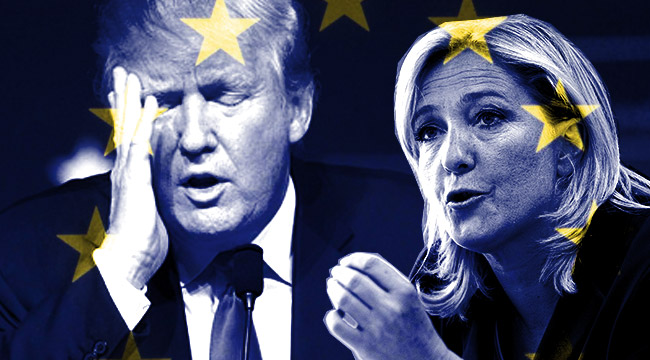
Trump’s poll numbers have not been good lately, thanks to his campaign gaffes, but among young voters in particular, he’s struggling to get any traction. Trump has just 20% support among voters under 35, according to USA Today‘s most recent polls. That’s worse than any President has ever experienced.
What makes Trump’s numbers stand out in sharper contrast, though, is how different they are from the rest of the Developed World. Across the world, Trump’s platform, albeit not Trump himself, is finding younger and younger ears. So what makes America, and its young voters, unique?
Right-Wing Sentiment Is Growing In Europe
Probably the most visible sign of right-wing sentiment in Europe was the narrow Brexit victory, which left Britain in political and economic turmoil. However, that election aligns surprisingly well with America in some ways; it was driven heavily by older voters, and it tended to be steeped in rhetoric about immigration. In fact, some voters believed they were voting on whether immigrants would remain or leave Britain, not whether Britain would stay in the EU.
Elsewhere in Europe, however, younger voters are going in droves for right-wing parties. In 2015, young voters swept the National Front, a far-right political party similar to the more extreme edges of the GOP, to a first-round victory in regional French elections, although it ultimately lost to more moderate right-wing Republicans in the second round. The anti-Eurozone AfD party of Germany has seen rapidly growing voter support among young men, despite only being three years old. The Sweden Democrats have been steadily building a power base since surprise wins in municipal elections in 2006. Italy’s far-left Five Star Movement is the most popular with voters under 50. Greece is in such dire straits that a blatantly neo-Nazi political party, the Golden Dawn, is seeing a rise in popularity.
Lumping all these movements together is a bit foolish; many of these parties would roundly reject Trump himself. They all, however, have broadly the same sentiments as Trump, much like Trump and Bernie Sanders were surprisingly similar on the issue of trade. They believe globalization, and more specifically the European Union, is dragging down their economy. They believe immigration is a serious social issue best solved by closing the border and tightening immigration restrictions. They argue government doesn’t reflect the will of the people. In fact, just like Trump is complaining about “rigged elections,” the National Front publicly claimed its second round loss in 2015 was due to party collusion.
So what’s happening? Why is America trending left, while Europe is headed to the right?
Europe’s Unspoken Problems Are Familiar To America
The issues, which will sound painfully familiar to many Americans, boil down to consequences of economics and rising social tension. Much of this has to do with the current rhetoric surrounding immigration in Europe: Immigrants are coming, they don’t want to assimilate in their host country, and they’re taking all the jobs that belong to “native” Europeans. The main problem, though, is that Europe desperately needs those same immigrants.
Simply put, there aren’t enough able-bodied Europeans to go around. Europe’s population is aging rapidly and by 2050, there will only be two workers for every retiree. In Liguria, Italy’s most elderly region, elder care is becoming an enormous social problem, and that’s just a taste of what Europe will face in the coming decades as its population retires, placing enormous stress on social welfare systems.
The European Union has generally solved this problem by lowering the bar for immigration from EU member states, something that many citizens of former Eastern Bloc countries have taken advantage of to find a better life. The UK alone has nearly 600,000 EU immigrants who might face deportation due to Brexit. And with that much immigration will inevitably come social tensions that Europe just may not be equipped to deal with. European nations view immigration far differently from America. The Statue of Liberty is French, yet she welcomes huddled masses not in Bordeaux or Calais, but in New York City’s harbor. America has been struggling with immigration and all the issues that come with it since the Pilgrims showed up in Plymouth Bay, and we haven’t stopped since.
Europe has never faced that problem, and for all the claims of freedom, open-mindedness, and social democracy, the strain is beginning to show in their elections. And part of that is a desire, whether couched in economic or in some cases racist terms, to “go back to the way it was before.” And the reality is, that’s impossible. Hillary Clinton may well defeat Trump in November, but unless Europe’s voters begin acknowledging some hard realities, it may begin electing some Trumps of its very own.
